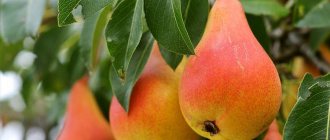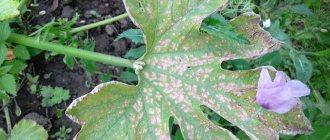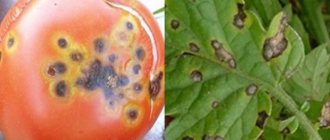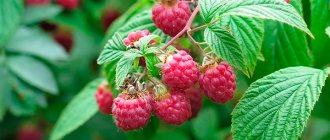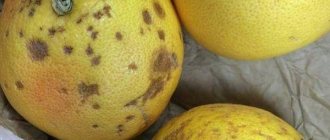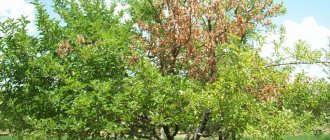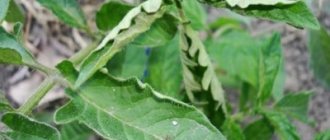Fungal diseases of plum
These diseases are easily transmitted from plant to plant. Favorable conditions for infection are high humidity and dense crown. Fungi actively spread in warm and humid summers, taking root in the tissues and creating a mycelium, they quickly destroy the tree, feeding on its fruits, leaves, and shoots. The fight against fungal diseases is carried out using special preparations - fungicides.
Coccomycosis
The fungus mainly affects leaves, less often fruits and shoots.
Causes. Occurs when there is high humidity and decreased immunity of the plant.
Symptoms. Around July, spots of red-brown or purple-violet color appear on the foliage. As they grow larger, they merge. On the reverse side of the leaves there is white-pink pubescence. Having turned yellow and brown, the foliage quickly falls off. The fruits dry out before they have time to develop.
Treatment. After harvesting, the tree is treated with 1% Bordeaux mixture. 1% copper oxychloride will also work.
Prevents coccomycosis by timely destruction of fallen leaves - the pathogen overwinters in it. In autumn, the soil near the trunk is dug up.
Rust
Appears in the middle of summer, affecting the foliage of the tree. A tree affected by rust weakens, loses its immunity and frost resistance.
Causes. The source of rust is anemone. This plant is also called anemone - it spreads spores of a fungus that overwinters on its rhizomes.
Symptoms. Brown spots appear on the leaves. If you do not deal with the problem, the spots turn into spore-bearing pillows. The leaves fall off, and fungi overwinter in them.
Treatment. There are no plum varieties that are 100% immune to rust, but each has its own susceptibility.
Standard prevention of fungal diseases (cleaning and burning residues, etc.) and planting varieties resistant to this disease - Anna Shpet and Renklod green - will help you avoid rust.
Brown spot
The second name of the disease is gnomoniasis. It affects many plants. You can lose up to 50% of the harvest.
Causes. Unfavorable weather, reduced immunity. Spores spread in the usual ways for fungi.
Symptoms. In spring, red-brown and ocher spots appear on the foliage, purple along the edges. The foliage on both sides is covered with black dots - fungal spores. The spots, growing in size, cover the entire leaf, which curls and falls off. The fruits, not having time to ripen, become deformed and spoil.
Treatment. Spraying before flowering with copper sulfate 1% (take 100 g of sulfate per 10 liters). After 2 weeks, when the tree has finished blooming, use 1% Bordeaux mixture. If the tree is heavily infected, then 2-3 weeks before harvesting the tree is sprayed again.
Prevention consists of digging up the soil, timely cleaning and destruction of fallen leaves.
Plum pockets
Excited by a vocal fungus. Plums become like bags. The fungal spores overwinter on the tree - it penetrates cracks in the bark and hides under the scales of the buds.
Causes. Appears during prolonged cold springs accompanied by high humidity. Fungal spores, having penetrated the flowers, infect them and damage the ovaries.
Symptoms. The disease deforms and spoils the fruit. Fungus grows and develops inside them. It sits in a “pocket” - hence the name of the disease. There are no seeds in the affected fruits. This type of fungus is only “interested” in fruits – it is not found on other parts of the plant. During the season, the disease appears only once: no fruit - no problem.
Treatment. In autumn - sanitary pruning. Burning affected shoots in early summer. Collecting and destroying rotten fruits is done before the spores spread. For prevention - spraying with Bordeaux mixture 3%. The first is before the buds open, the second is before flowering, the third is after flowering.
If the disease is not treated, it can take away more than 50% of the harvest.
Clusterosporiasis
The fungus affects all above-ground parts of the tree. The fungus overwinters in tree wounds; it can also take a liking to shoots and buds.
Causes. The ways of spreading spores are through the air, insects, and equipment.
Symptoms. Brown spots with a reddish edge are visible on the leaves. Holes appear in place of the spots. Due to the through holes in the leaves, cleasterosporiasis is also called hole spot. There are also spots on the shoots, the bark cracks, the foliage dries, the buds turn black, and the flowers fall off - the tree simply dies. The fruits first become covered with spots, then puff up, and gum flows from the spots. The fruits dry out and decrease in size.
Treatment. The tree needs regular spraying. At the initial stage of bud bursting, the tree is treated with 1% Bordeaux mixture. Repeat - during the appearance of buds. The next treatment is after flowering. The fourth - a couple of weeks after the tree fades. The last, fifth spraying is 3 weeks after removing the plums.
In case of severe infection - with damage to the shoots, it is recommended to treat the tree again - after the leaves fall, but not 1%, but 3% with Bordeaux mixture.
Preventive measures: remove and burn fallen leaves and fruits in a timely manner, dig up the soil in the tree trunk circle, remove diseased branches, lubricate wounds.
Stone fruit moniliosis (gray rot)
The full official name of this dangerous disease is monilial stone fruit burn. But among gardeners it is more often called gray rot. The disease is caused by the fungus monilia, which overwinters on shoots and unharvested fruits. The disease threatens the death of the tree.
Causes. The tree becomes infected during flowering - during temperature changes. Fungal spores, penetrating through the pistil deep into the plant, gradually infect all its parts.
Symptoms. The flowers and adjacent leaves dry out. The branches crack and thick sap begins to flow from them. A tree affected by moniliosis looks like it has been burnt. The shoots turn brown, wither, and thickenings appear on the bark. Fruits grow from the surviving flowers, but they are also affected by fungal spores. On plums, the disease is most manifested by fruit rot - they rot right on the branches. There are gray thickenings on the skin.
Treatment. Treatment with copper or iron sulfate 1% and Bordeaux mixture 1%. All rotten plums are destroyed, and the trees themselves are again treated with 1% Bordeaux mixture.
To prevent moniliosis, gardeners collect and burn fallen leaves, fruits and shoots, fight pests, repair wounds and damage to the bark, and whiten the trunk.
Witch's broom plum
Often called bushiness or plum growth. At the site of the lesion, all parts of the plant are affected.
Causes. The development of the disease is facilitated by damage to plants, including those caused by insect pests.
Symptoms. In places where the fungus is localized, thin, sterile shoots grow en masse. Branching shoots look like brooms. On diseased shoots, the leaves become smaller and quickly fall off. At the end of summer, a gray coating appears on the leaves - these are fungal spores.
Treatment. Shoots affected by the fungus are cut off and burned. The tree is sprayed with Bordeaux mixture 3% until buds form. When the plum blossoms, spray again with 1% Bordeaux mixture. You can also treat the plum with fungicides.
Ordinary sanitary measures help to avoid the disease - timely removal and destruction of affected shoots, digging up the soil, and preventive spraying with Bordeaux mixture.
If there was a crop failure, in a field or garden, people were always looked for to blame. Many believed that the thinning of the shoots was the work of a witch. The unusual name has survived in its original form to this day.
milky shine
It affects the branches - they die, and then the tree itself dies.
Causes. Transmitted from infected trees. It affects trees that are frozen in winter and those with bark damage.
Symptoms. The leaves, becoming silvery and brittle, dry quickly. On the darkened bark, a fungus appears in the form of plates of different colors. These formations are firmly attached to the bark, their width is 3 cm.
Treatment. Absent. It is necessary to increase the frost resistance of the plum, insulate it for the winter, whiten the trunk, and lubricate the cuts with garden varnish.
It is recommended to buy seedlings from trusted sellers - in reliable nurseries, and destroy infected plants in a timely manner.
Fruit rot
The symptoms are similar to moniliosis (gray rot), but only affects fruits – those that have damage.
Causes. The fungus spreads intensively in damp, rainy weather.
Symptoms. Brown spots appear on plums, quickly growing and covering the entire surface of the fruit. Symptoms of rot appear in July, when plums are pecked by birds and eaten by insects.
Treatment. Trees are treated with 1% Bordeaux mixture.
To prevent fruit rot, pests are destroyed in a timely manner, and rotten plums are buried.
After destroying infected fruits, the gardener must thoroughly disinfect his hands. If you touch healthy fruits with unwashed hands, the fungus will immediately be transmitted to them.
Plum polypore
This fungus settles on the trunk of a tree (it affects plums, cherries, cherries, and, less commonly, apple and pear trees).
Causes. Penetration occurs through areas affected by sunburn, frost, and insects.
Symptoms. Mushrooms appear in the form of growths on the trunk. The mushroom has a hard, hoof-shaped body. At first its surface is velvety, and then smooth gray-black.
Treatment. Treatment of wounds and cracks in the bark. Destruction of the fruiting bodies of the fungus. The damage is washed with a solution of copper sulfate, then filled with sand-cement mortar.
All dry and damaged branches are removed and burned in a timely manner - they are the ones that attract tinder fungi.
Sooty fungus
Gardeners often call this disease rabble. The pathogen lives in colonies on leaf blades. Fungal formations interfere with normal photosynthesis, which leads to weakening of the tree.
Causes. The carriers of the fungus are parasitic insects. Appears when there is excessive dampness.
Symptoms. Leaves and shoots are covered with a black coating that can be easily wiped off.
Treatment. Spraying with soap and copper solution. Dissolve household soap shavings (140 g) and copper sulfate (5 g) in water (10 l). For prevention, it is necessary to prevent thickening of the crown and destroy pests in a timely manner.
Plum leaves turn black
If the plum leaves darken so much that they begin to turn black, the root system is probably damaged. It could also be bacterial lesions or fungus.
— Chaotic but small black spots are left by brown spotting. More precisely, at first the spots are colored yellow or brown, but gradually they are covered with black dots;
— Black sooty coating covers plum leaves due to the sooty fungus of the same name;
- Black spots on leaves and shoots, reminiscent of burns with ulcers - terrible bacterial necrosis that can destroy the tree;
— If the root system is damaged, rotted or burned, the above-ground part also turns black and dies. The first thing that suffers is young and fragile shoots with leaves.
Photo: zen.yandex.ru
Petunia leaf diseases: descriptions with photos, treatment
Infectious (viral) diseases of plum
Viral diseases are especially dangerous - they have practically no treatment. Viruses are transmitted by insects.
Plum pox (sharqa)
Gardeners often call this disease smallpox. This viral disease affects the leaves - they become covered with spots and stripes, becoming “marbled”. The disease is widespread everywhere - in the south and in the middle zone.
Causes. The plum tree is infested by insects. The virus is transmitted by aphids - it settles on different plants. The source of infection can be sweet clover, nightshade, and clover. The virus can lurk in seedlings and is often carried by garden tools.
Symptoms. Spots appear on the fruits, the pulp is affected down to the very seed, and loses its natural taste. The spots become depressed over time. The affected fruits, ripening ahead of schedule, fall or, having dried out, remain hanging on the branches.
Watch a video about the plum virus disease “Sharqa (sharka)”:
Treatment. The disease cannot be cured. All infected trees are burned. The fight against smallpox lies in its prevention - the timely destruction of virus carriers.
When pruning several trees in succession, it is important to disinfect pruners and other tools.
Plum dwarfism
It is caused by a virus that multiplies in the cells of living organisms. The tree slows down and then dies.
Causes. Distributors are parasitic insects (aphids, mites, etc.).
Symptoms. The leaves become smaller and then become deformed. Tufts of diseased foliage form at the tips of the branches. The buds become deformed or do not grow at all.
Treatment. Like most viral diseases, dwarfism has no cure. Sick trees are uprooted and burned.
To avoid infection, planting material is purchased from reliable nurseries, pests are destroyed in a timely manner and all necessary preventive measures are carried out.
White coating on plum leaves
The white fuzzy coating is the spores of a fungus that multiplies in this way. Sometimes it can be mistaken for a thin sticky web left by pests.
— The most common garden problem is powdery mildew, which spreads quickly on humid days;
— Plum leaves seem to become silvery due to their milky shine. Air voids appear in damaged plates;
— A whitish web on the leaves is left by spider mites and some types of caterpillars.
Photo: yard.hozvo.ru
Bacterial diseases
The causative agents of this group of diseases are bacteria and microbes. Infection usually occurs through tools or seedlings purchased from random suppliers.
Root cancer
The cancer is active and affects almost all fruit trees.
Causes. Pathogens are bacteria found in the soil. Bacteria enter plant tissue through damage to the roots. Provocateurs are severe droughts and slightly alkaline environments.
Symptoms. Growths appear on the roots of the plum tree.
Treatment. Sick trees are destroyed. The soil is disinfected with copper sulfate. All instruments are disinfected with 0.5% chloramine.
It is recommended to locate the garden in areas free from root cancer.
Bacterial burn
This disease can destroy the largest tree. The disease affects trees in spring and autumn.
Causes. The provoking factor is dampness. Infection occurs from diseased plants that are carriers of the bacterium.
Symptoms. Affects the entire above-ground part of the tree. The bark is cracking. The leaves and buds, turning black, dry out. The flowers turn dark brown and fall off.
Treatment. Spray until buds form with a 1% solution of copper sulfate (100 g of substance per 10 liters of water). Treated with antibiotics.
To avoid infection, only healthy seedlings are used, and infected branches and entire trees are destroyed in a timely manner.
Prevention of diseases and damage by pests
Diseases and pests greatly harm the plant, reduce the number of healthy fruits, leave immunity and can even cause the death of the tree. Therefore, it is necessary to prevent their occurrence in advance. For this purpose, prevention is carried out. For this purpose, they resort to the help of chemicals, as well as special agricultural techniques.
- In early spring, cut and get rid of diseased shoots. Cover cracks caused by frost with garden varnish. Dig up the soil in the near-trunk area. Spray with 3% nitrafen.
- During the flowering period, you should not resort to chemicals. You can use a honey solution. To prepare it, mix 30 g of the substance in a bucket of water. Microfertilizers are also allowed: 1 tablet or 1 tbsp. for 10 liters of liquid.
- After the growing season, you will need 0.2% chlorophos, 0.4% vitriol and 0.5% copper with oxychloride.
- At the ripening stage, collect and dispose of the infected connection.
- In the fall, collect weeds and fallen leaves, whiten the trunk, dig up the soil near the plant
- Repeat whitewashing in late autumn.
These procedures must be repeated constantly. If at least one tree shows signs of infection, it is important to immediately take the necessary measures.
Gardeners often lose trees due to various diseases and insects. To avoid such consequences, you need to be careful. Photos of plum diseases and parasites will help beginners identify them in time and get rid of them.
Non-communicable diseases
Non-communicable diseases are caused by violations of agricultural practices. Improper care - pruning or watering - can cause systemic problems that cannot be treated with conventional medications.
Gum treatment
The second name is gommosis. This disease is typical for all stone fruit trees. It is not infectious, but that makes it no less dangerous. If measures are not taken in time, the tree dies.
Causes. Most often it appears on trees damaged by severe frosts or suffering from fungal or other diseases. Gum discharge often indicates excessive soil moisture or acidity. Often the problem arises in the gardens of inexperienced gardeners who have exceeded the dosage of fertilizers.
Symptoms. On the trunk there are drops of translucent gum (resin). There is a risk of infections entering through gum-cutting wounds.
Treatment. To save a tree from bleeding gum, you have to perform a whole range of measures:
- The place where the gum leaks out is cleaned with a garden knife.
- Disinfect the wound with copper sulfate 1%.
- After a couple of hours, the wound is rubbed with sorrel leaves - this is repeated several times.
- Cover the damaged area with garden varnish.
To prevent gum growth in plums, they need proper care - moderate watering, correct dosage of fertilizers, treatment of wounds after pruning.
Drying out
This disease is caused by violation of plum growing conditions.
Causes. Close occurrence of groundwater, gum formation, freezing. Strongly alkaline or acidified soils contribute to drying out. Salt marshes are also not suitable for plums.
Symptoms. Drying of leaves.
Treatment. Elimination of factors provoking the disease. Compliance with the rules of agricultural technology.
Leaves turn yellow and dry out
Plum leaves turning yellow by autumn is a normal process, but what if this happens at the height of the season? Let's talk about the most common reasons!
— Due to a lack of moisture, plum leaves turn yellow and dry, and due to its excess, they turn yellow and rot;
— After rains, the sun may cause burns, which is why it is not recommended to water and spray trees at the height of the day;
- Chaotic yellow spots may be a sign of plum pox or sharki. They resemble curved lines, loops or rings;
— If yellow spots on the leaves are woven into one complex pattern, this is an incurable mosaic;
— Leaves eaten by pests also gradually turn yellow and dry out. This is often caused by voracious fruit mites or scale insects;
— Drying is a common problem for all stone fruits when agricultural practices are violated. Its causes are the wrong choice of location and soil, lack of lighting or humidity, destructive pruning, neglected gum growth, and frost.
Photo: 2sotki.ru
Leaf diseases in phlox: descriptions with photos, treatment
Parasites
The plum tree has plenty of enemies among insects. Parasitic pests weaken the tree, reduce productivity, and can even destroy it.
Gall mite
These are micro-insects of a purple or pink hue.
Harm. Parasites settle in growths located near fruit buds - in galls. There are 4 hundred mites in one gall. At the end of spring, mites crawl out to feed on the cellular juices of the plant. The damage to a tree by a mite is indicated by ugly reddish growths - they form in the affected areas.
Treatment. As soon as the plum blossoms, it is treated several times with colloidal sulfur. If the damage is widespread, the affected shoots are cut off and burned. Insecticides are effective at the initial stage of mite activity.
To prevent infection, trees are sprayed in a timely manner, whitened, wounds and cracks are covered, and agricultural practices are followed.
Goldentail
This is a small butterfly from the silkworm family. It is often mistaken for a harmless night moth. She has a yellow, almost golden belly and shaggy antennae. The caterpillars are hairy, gray-black, with an orange-red pattern. The length of the caterpillar is 4 cm. The butterfly lays eggs directly on the leaves.
Harm. The harm to the lacewing becomes obvious as soon as the buds bloom - the caterpillars greedily eat them. Voracious pests quickly eat the foliage, causing irreparable damage to it. Tree growth slows down. Left without leaves, the tree may die altogether.
Treatment. Spraying with karbofos solution.
Attracting predatory insects and birds to the garden helps prevent the invasion of golden-bellied butterflies. For example, the tahida fly feeds on larvae. Vigilant inspection after leaf fall is also necessary. Having discovered cocoons on the branches, they are collected by hand. If there are a lot of cocoons, the affected branches are cut off and burned.
Plum moth
The pest is a gray-brown butterfly. She lays eggs in green plums.
Harm. Caterpillars hatching from eggs eat the pulp of plums. Spoiled fruits, darkening, quickly fall off.
Treatment. Preventive spraying with karbofos helps.
To reduce the number of moths, I cultivate the soil to destroy the insect’s nesting sites. All damage is disinfected with manganese and covered with garden varnish.
Aphids on a tree
“Harms” of small, pale green insects harm trees by drinking their juices.
Harm. Aphids, feeding on the juices of the plum, weaken it. The tops of the tree's shoots curl, it grows poorly, and the leaves dry out and fall off. If you turn the leaf over, you can see a colony of aphids on the reverse side.
Treatment. As soon as the growing season begins, the tree is sprayed with aphids. After 2 weeks – re-treatment.
Proper agricultural practices, timely destruction of pests, loosening the soil, removing weeds, etc. help get rid of aphid attacks.
hawthorn
This is a large daytime butterfly with a wingspan of 6.5 cm. It is white and black in color, with black veins on its wings. The caterpillars are furry and have black and orange stripes.
Harm. The pest eats everything except the bark. The plum weakens and dies.
Treatment. Use the full range of possible means. The caterpillars are shaken down, the trees are sprayed with insecticides, and treated in early spring with a solution of urea and copper sulfate (500 g of urea and 100 g of vitriol per 10 liters of water). Plums are sprayed with insecticides before and after flowering. DDT, Metaphos, Thiophos and other drugs are used.
Prevention measures include attracting birds to the site, regularly inspecting trees, and feeding them with mineral and organic fertilizers.
Plum sawfly
An adult insect has membraned wings. It feeds on the juice and pollen of inflorescences. Damage to the tree is caused by larvae - pale green pseudo-caterpillars. Sawflies lay eggs in flower buds.
Harm. The hatched larvae penetrate the fruit and eat the pulp of the ovary. Offspring of the 2nd and 3rd instars eat part of the fruit near the seed. Spoiled plums fall off.
You can see the damage caused by the Plum Sawfly larvae in the following video:
Treatment. Treat with Karbofos 10%, Benzo-phosphate 10% - in places where insects are most concentrated. The first treatment is 2 days before flowering. You can spray with Rogor, Gardon, Tsidial. The second spraying is aimed against the larvae, it is carried out after flowering - the tree is sprayed with Tarzan or Novaktion.
Prevention of sawfly damage involves destroying the larvae by loosening and deep digging of the soil. It is recommended to remove wormy fruits by shaking.
Plum weevil
This beetle is bronze in color with a red-copper sheen. The length of the insect is 3.5-4.5 mm. Covered with thick hairs. The larvae are yellow-white, the head is brown, arched.
Harm. The beetles eat the buds in the spring, then move on to the leaves. Females lay eggs in the pulp of the ovaries. Once born, the larvae eat the plum pulp. The larvae then pupate in mummified fruits, and adult beetles emerge from the soil in the autumn season.
Treatment. Spray with insecticides - Karbofos, Vofatoks and others. The first treatment is before flowering.
Prevention is similar to measures to counteract the plum sawfly - loosening, digging, destroying affected fruits and other agrotechnical measures aimed at destroying pests.
Most plum diseases are treatable, and the earlier the fight is started, the more effective it is. Prevention deserves special attention - many diseases can be prevented thanks to timely spraying and proper agricultural technology.
0
0
Copy link
Description of the signs of insect pests, how to fight
There are many known pests that, if they have taken a fancy to a fruit tree, will take root on it, multiply and will certainly destroy not only the entire harvest, but will also lead to the death of the plant. Only timely treatment will help preserve fruit trees and protect the garden from insect invasion.
Goldentail
It is at night that this white butterfly leads an active lifestyle, laying eggs (up to 300 pieces) on a plum tree under the leaves, on the branches. Greenish caterpillars of the pests appear after 2 weeks and feed on tree foliage. The caterpillars should not be touched with hands, as they secrete a liquid that is poisonous to humans. The skin turns red and the hands begin to itch.
Ways to fight
- Treatment of trees before flowering with karbofos (0.3%).
- Timely destruction of insect nests.
Plum moth
A common pest of stone fruit trees. The brownish-gray upper wings of the insects have rounded spots of a darker color, while the lower ones are fringed. The body of the reddish caterpillars grows up to one and a half cm in length. Insects overwinter under the bark and under trees. After oviposition, voracious caterpillars appear a week later.
Capture and processing
- Arrangement of catching belts for catching caterpillars.
- While the caterpillars crawl into the ground, it is advisable to loosen the soil near the tree trunks approximately once every 10 days.
- Spraying with 10% benzophosphate or 10% karbofos.
Plum aphid
Colonial insect pest that damages the entire tree. Aphids attack the lower plate of leaves, they curl and dry, fruits wrinkle and rot, young branches bend, and the tree weakens. Aphids leave behind a liquid that has a beneficial effect on the development of sooty fungus.
How to fight
- In spring, root shoots should be removed.
- Spraying with nitrophen. Held in early spring.
- When the buds open, the pest is treated with a soap solution and tobacco infusion,
- Coating trunks and trunk branches with insect repellent glue, such as “Blockade”.
hawthorn
Large butterfly with white wings. The insect is diurnal. The lower and lateral parts of the caterpillar's body are gray in color, the body itself is fluffy and covered with hairs. The caterpillar is easy to recognize. The back is decorated with two brownish with a yellow tint and three black stripes. Caterpillars that spend the winter in dry foliage and crawl out of it with the arrival of spring feed on the swollen buds, eating them completely.
Fighting methods
- Collection and burning of pest nests.
- Plums are sprayed with actellik, corsair with a concentration of 0.1% in accordance with the instructions at the end of April or at the beginning of May.
Ringed silkworm
Ringed silkworm caterpillars destroy stone fruit crops, damaging foliage and buds. Butterflies and caterpillars “work” at night. The wings of the butterfly are brownish in color with dark stripes. The pest's caterpillars are gray, with blue stripes on both sides and orange on the back. Between the orange ones, along the entire length of the insect’s back, there is a white stripe. At night, the butterfly lays eggs on parts of the tree. How to recognize a caterpillar. In addition to the color difference, they can also be recognized by their behavior: if you touch her head with your finger, she will sharply turn it to the side.
How to fight
- It is better to fight in rainy weather, when the caterpillars are hiding in their nests.
- Remove and burn winter nests.
- It is recommended to use insecticides on plums: Dendrobacellin, Antobacterin.
- Among the folk remedies, treatment with infusion of tobacco, wormwood, and chamomile helps.
And finally.
Signs of appearance
This disease is very easy to recognize visually even in the early stages:
| Sign 1. The appearance of spots on the foliage The first signs of a tree being infected with coccomycosis are the appearance of small brown spots on the leaves closer to the beginning of the summer season | |
| Sign 2. The appearance of convex areas In mid-summer, there are a lot of spots on the leaves, and on the back of the leaf you can see large gray and pinkish convex spots. Fungal spores “live” in these bulges | |
| Sign 3. Yellowing of leaves By the end of summer, the affected leaves turn yellow, curl into a tube and fall off within a month | |
| Sign 4. Cracks and spots on the bark and fruits In later stages, the disease can be recognized by cracks in the bark and spots on the shoots and fruits |
Ways to fight: 2 folk remedies + 3 drugs
Folk methods of combating scab on fruit trees and other plants:
An excellent folk remedy for scab is mustard solution:
- before processing, collect all affected fruits and leaves and bury them in the ground or burn them;
- Dilute 80 g of mustard powder in 8 liters of warm water;
- spray the tree trunk circles and affected areas of the plant with the solution;
- repeat the treatment 3 times per season: during bud break, bud formation and fruit formation
A great way to get rid of scab on apple and stone fruit trees:
- before processing, collect all affected fruits and leaves and bury them in the ground or burn them;
- dissolve 5 g of the drug in 10 liters of water;
- spray trees and trunk circles 3 times per season: during the swelling of the buds, the formation of buds and the ovary of fruits;
- after treatment with this solution, harmless brown spots may appear on the apple tree and fruits, which will disappear in a couple of months
Chemicals for controlling scab in the garden:
This is one of the most effective drugs for combating fungal diseases in the garden.
How to use:
- dissolve 200 g of the substance in 10 liters of water;
- The solution must be used immediately after its preparation so that it does not have time to infuse;
- You can treat seeds and seedlings with a solution of this drug before planting;
- to treat the disease in the initial stages, spray the plants 3 times during the growing season with an interval of 12 days
This drug is non-toxic to humans and animals, effective at high temperatures and very economical.
Minus - it acts locally, only on treated areas of the plant.
